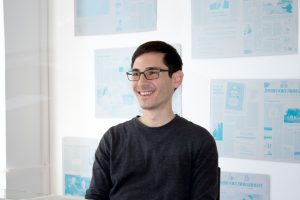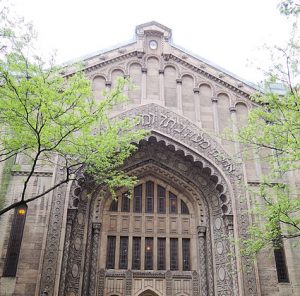“Sim Shalom” – with his new composition just released young Berlin based Israeli composer Gilad Hochman revives the tradition of synagogue music
Grant peace to the world, goodness and blessing, grace, love and compassion for us and all the people of Israel…” – the blessing “Sim Shalom” features twice on the album “Heritage”. Just released on the eve of Yom Kippur, it is dedicated to “Treasures of Jewish-German Composers”. And it just sounds like a long and rich tradition is being continued by a young composer – Gilad Hochman, an Israeli who has found inspiration in Berlin.

Gilad Hochman
Liturgical music is new grounds for Hochman. Acclaimed for his chamber music and his pieces for solo instruments and for symphony orchestra, Hochman by his own account “had never dealt with this kind of music before. I had never composed for a chazan or with the idea that my music will be performed in a synagogue. But after some time, music just started to surface.” He smiles. Suddenly, “there was a natural feeling about composing this old Hebrew text … after all, it’s not the first time I relate to Jewish topics – but there was an additional layer of spirituality being a part of the actual process of composing.”
Why “Sim Shalom”? When commissioned to contribute a piece for the collection “Heritage”, Hochman “started reading and was immediately captured by the Sim Shalom blessing which puts ‘peace’ at its centre by repeating the word several times.” And then, Gilad Hochman began talking to Azi Schwartz. The Israeli born celebrated cantor of New York’s Park Avenue Synagogue introduced Hochman to the rich tradition of Jewish liturgical music created in Europe. Much of it in Germany. Take Louis Lewandowski, the doyen of liturgical melodies, in his days deemed the “Mendelssohn of synagogue music.” His “Tsadik Katamar” features in “Heritage” as does Israel Alter’s “R’tze Vimnuhateinu.” And then, there are fine samples of this very special worldly-spiritual music composed by those having left the old continent behind to become part of the New World. Richard Rodgers, born into a German-Jewish family in New York, one of America’s greatest composers of musicals. Or the amazing Kurt Weill, son of a cantor from Dessau. Both, his “My Ship” and “Kiddush” feature in “Heritage.” Vastly different spiritual journeys through music.

Park Avenue Synagogue in New York
CC0 1.0 Universal (CC0 1.0)
Public Domain Dedication https://creativecommons.org/publicdomain/zero/1.0/deed.en
The sound of silence
In his “Sim Shalom” Hochman, a classically trained composer, develops a dialogue between the chazan, steeped in Jewish tradition, and a choir, using specific modal scales, known in medieval tradition. The result of this experiment makes you hold your breath. Silence. Filled with tension, meaning, resolution, and ultimately redemption. Silence. As always in Hochman’s work.
“I know that a piece works the moment there is no sound, silence,” Hochman says. And here these split seconds work towards “offering a bridge where people of different beliefs can find a common cultural and spiritual place.”
Hochman is very happy with the recording of his latest piece. Berlin’s RIAS Kammerchor, voted “one the world’s best ten choirs”, directed by the young British Conductor, Justin Doyle, has the range of purity, emotion and depth needed for liturgical music. “It was obvious to me that they love their work,” says Hochman, “Our connection was immediate.”
Why two renderings of “Sim Shalom” on one album? Max Janowski’s beautiful piece shows a certain restraint and seeks to hold, to preserve. Hochman’s finds doubt, departure, and hope. Grant peace to the world.
“I am intrigued by the connection between the words Shalom (meaning peace) and the word shalem (meaning being complete, whole)” … muses Hochman. Hopefully he will put his reflections on this connection into music soon.
